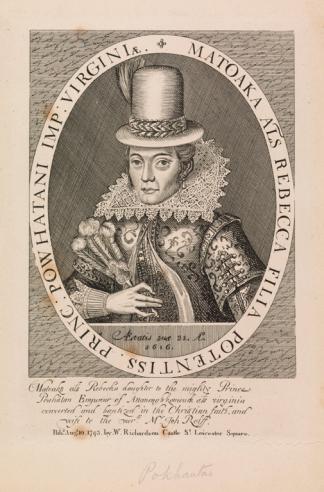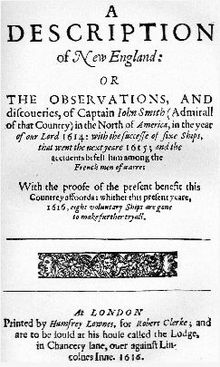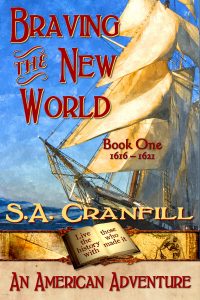
A Most Interesting Year for Some Famous People
Do you know who was in London in 1616? All at the same time? The same year (or very close) that Dutch artist Claes Visscher published his magnificent etching of a panorama of London? Did you guess Lady Rebecca Rolfe, a Massachusetts Patuxet called Tisquantum, and the soldier-adventurer Captain John Smith? If you did, you are truly a history nerd!
Did they meet while in London? Two of them had a well-documented meeting. The third? No proof or mention, but perhaps a possibility, if we use our imaginations. Let’s find out more about what happened in London in 1616 and how it impacted the New World called America.

1616 Engraving in London by Van de Passe
Pocahontas in London?
Who was Lady Rebecca Rolfe? Her birth name was Matoaka, but does her nickname Pocahontas sound more familiar? How did she go from Matoaka to Rebecca, and from an aboriginal “Virginian” to a titled Englishwoman?! The Powhatan princess had married English commoner John Rolfe in 1614. She had converted to Christianity through a protestant clergyman and taken the name Rebecca. Why was she in London? Pocahontas and her husband had arrived at the port of Plymouth, England, in June of 1616, on an important visit to promote the Peace of Pocahontas that was now blessing the fragile colony of Jamestown. Things were finally looking up in Jamestown, and the Virginia Company of London was most anxious to lure more colonists to its investment and to promote the new, very special tobacco that arrived with the Rolfes in the hold of their ship. The hope of Jamestown had arrived, in both a person and a plant.
But Rolfe was only a commoner. How was it that his wife was officially Lady Rolfe? It was thanks to the London company investors, who had insisted that the father of Pocahontas, Powhatan overlord Wahunsenacawh, be crowned king of the Powhatans. That made Pocahontas the daughter of a king and granted her (but not her husband) the privilege of visiting the royals of Whitehall, a subject which caused great concern to none other than Captain John Smith.
Pocahontas Mad at Captain John Smith?
Why did such a meeting worry John Smith, and how do we know that it did? All manner of myth and controversy continues to swirl around the fabled relationship of Pocahontas and John Smith, both recognized as saviors of the colony of Jamestown. John Smith left Jamestown in 1609 sorely wounded. His amazing survival and subsequent vitality speaks volumes to his fitness and toughness. He was truly quite a guy. Pocahontas believed him to be dead. He never communicated with her (and later stated his regrets).

John Smith’s Description of New England Published 1616
Upon arriving in Plymouth after her first (and only) ocean voyage, Pocahontas discovered John Smith was indeed alive! His A Description of New England: or the Observations, and Discoveries, of Captain John Smith, Admiral of that Country, in the North of America, in the Year of Our Lord 1614 was hot off the press. Pocahontas was miffed, to say the least, and not at all happy with her old friend.
Though John Smith had turned his attention to what he had named New England as the prime opportunity for the future of British colonists, he still felt and understood the vital value of Jamestown. Virginia was at stake, and the Rolfes held two keys to its success. How would King James and Queen Anne treat the arrival of the Powhatan princess turned “lady”? Would they receive her graciously,… or at all, due to her origins and the king’s extreme distaste for, and disapproval of, tobacco? So the worried Smith wrote a letter to the queen. A quite amazing letter, especially considering the culture of the times.
Squanto in London?
And what of Tisquantum, or Squanto, as William Bradford would call him years later in his first-hand account, Of Plymouth Plantation? The New England trip newly advertised by Smith was the reason for Squanto’s London residence. A greedy brute of a ship captain named Hunt, part of Smith’s expedition, had kidnapped (unknown to Smith) a number of natives from the Cape Cod region for sale as slaves in Spain (for Hunt’s personal profit). Rescued by Catholic friars, Squanto somehow made his way to London where he was taken in by a merchant venturer named John Slany, treasurer of the Newfoundland Company. (The name is spelled both Slany and Slaney and I chose the first.) The company boasted notable nobles, including Sir Francis Bacon, and there was certainly interest in Squanto’s native knowledge and Algonquin (or Algonkin) language.
 So, during this year 1616, was Squanto ever introduced to either Pocahontas or Smith? What about Smith’s letter to the queen? What about the reception of the Lady Rolfe? How did Squanto get from London to America’s New Plymouth? Want more of the story? Actually, stories? Oh, there is so much more. For as much as I’ve been able to find, documented with all the references I could access, enlivened by imagination, presented in “as you live it” story form, stay tuned for the upcoming release of Braving the New World, Book One, 1616 ~ 1621. It is written and in production, complete with study guide, due out for this year’s 400th anniversary of the arrival on American shores of the Mayflower.
So, during this year 1616, was Squanto ever introduced to either Pocahontas or Smith? What about Smith’s letter to the queen? What about the reception of the Lady Rolfe? How did Squanto get from London to America’s New Plymouth? Want more of the story? Actually, stories? Oh, there is so much more. For as much as I’ve been able to find, documented with all the references I could access, enlivened by imagination, presented in “as you live it” story form, stay tuned for the upcoming release of Braving the New World, Book One, 1616 ~ 1621. It is written and in production, complete with study guide, due out for this year’s 400th anniversary of the arrival on American shores of the Mayflower.
And more will appear in this blog and in planned e-books in my History & Lit Shorts series. History is indeed fun, and the best stories are true.

